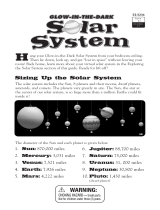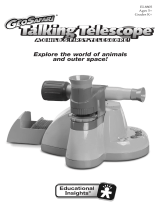
9
Tips for Telescope Use
Exploring the night sky with a telescope is exciting—and challenging! Learning to use a telescope takes practice
and patience. Here are some tips to better viewing:
1. To locate objects, you must first learn how the sky is laid out. Check books about astronomy to learn your way
around the night sky. Then consult one of the web sites on page 12 to check the location of interesting celestial
s
ights. Local astronomy clubs are a good source of information, too.
2
. No matter how much light surrounds you, more is always worse. Turn off any lights you can. Also, allow 15
minutes or more for your eyes to adapt to the darkness.
3. Cool your telescope to the outside temperature for about 30 minutes before observing. Cooling the telescope
reduces air currents inside the tube that could produce fuzzy, blurry images.
4. Planetary viewing requires good “seeing” conditions—steady, dry atmosphere with little or no clouds. A good
way to judge seeing conditions is to check the stars. If the stars appear to be twinkling, a phenomenon caused by
a turbulent atmosphere, then conditions are poor for planet gazing.
5. Use slow, steady hand movements when using your telescope. This will minimize vibrations and make it easier to
get a better view.
Frequently Asked Questions
1. Why is the image in my telescope eyepiece upside down and/or backwards?
If you have inserted your eyepiece directly into the telescope’s focusing tube, you will see an image that is
upside-down and backwards. If you have inserted the diagonal mirror into the focusing tube and then placed the
eyepiece into the diagonal mirror, your image will be right-side up, but it will still appear backwards or reversed,
like the reflection in a mirror. This is normal for an astronomical telescope.
2. Why can’t I see anything when I look through my telescope?
If you see only white, gray, or black through the telescope, there are two likely causes. The first is that you
have inserted an eyepiece that is too powerful. To solve this problem, switch to a lower power eyepiece. As a
rule, always start with the lowest power eyepiece (25mm), gradually switching to the higher power eyepieces
only after you have located an object. The second cause is that the finder scope is not properly aligned. See
page 7 of this guide for the procedure to properly align your finder scope.
3. When I use my high power eyepiece, why does everything look darker?
As telescope magnification increases, brightness diminishes. Brightness increases when magnification is reduced. If
an image appears dark or unclear, try using your low power eyepiece. It is easier to study small, bright views of
celestial objects than large, dark, or blurry ones. You do not need very high powers to study most celestial objects.
4. Why do objects in the sky move out of view when I look through my telescope?
When you view a celestial object through a telescope, the rotation of the earth makes it appear as though
objects are moving across the viewing area. You can lessen this effect and observe the largest area of the sky
by using your low power lens.



























